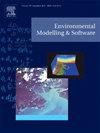Attention scores and peak perception in long-term ozone prediction using deep learning
IF 4.8
2区 环境科学与生态学
Q1 COMPUTER SCIENCE, INTERDISCIPLINARY APPLICATIONS
引用次数: 0
Abstract
To address the limitations of traditional ozone (O3) forecasting models, this study established a novel Transformer-based model integrating attention scores and the peak perception. Attention scores dynamically quantify nonlinear relationships between O3 and influencing factors, while peak perception method penalizes peak O3 errors, ensuring accurate predictions during O3 exceedance events. Our results demonstrate that the proposed model significantly improves the prediction accuracy for both hourly and maximum daily 8-h average O3 concentrations, with the R2 value increasing from 0.56 to 0.83 and the mean squared error decreasing from 0.47 to 0.42. Wind direction, wind speed, and carbon monoxide emerged as dominant factors during pollution episodes. Additionally, the model exhibits a high potential for predictability over extended lead times, with a mean absolute error of 0.67 at 24 h, stabilizing at 0.75 at 72 h. This approach enhances simulation accuracy and provides policymakers extended response windows for O3 control strategies.
使用深度学习的长期臭氧预测中的注意分数和峰值感知
为了解决传统臭氧(O3)预测模型的局限性,本研究建立了一种基于transformer的模型,将注意力得分和峰值感知整合在一起。注意评分动态量化了O3与影响因素之间的非线性关系,而峰值感知法对峰值O3误差进行了惩罚,确保了O3超标事件的准确预测。结果表明,该模型显著提高了每小时和最大日8 h平均O3浓度的预测精度,R2值从0.56增加到0.83,均方误差从0.47减少到0.42。风向、风速和一氧化碳是污染期间的主要影响因素。此外,该模型在延长的交货期内具有很高的可预测性,24小时的平均绝对误差为0.67,72小时时稳定在0.75。这种方法提高了仿真精度,并为决策者提供了延长的O3控制策略响应窗口。
本文章由计算机程序翻译,如有差异,请以英文原文为准。
求助全文
约1分钟内获得全文
求助全文
来源期刊

Environmental Modelling & Software
工程技术-工程:环境
CiteScore
9.30
自引率
8.20%
发文量
241
审稿时长
60 days
期刊介绍:
Environmental Modelling & Software publishes contributions, in the form of research articles, reviews and short communications, on recent advances in environmental modelling and/or software. The aim is to improve our capacity to represent, understand, predict or manage the behaviour of environmental systems at all practical scales, and to communicate those improvements to a wide scientific and professional audience.
 求助内容:
求助内容: 应助结果提醒方式:
应助结果提醒方式:


